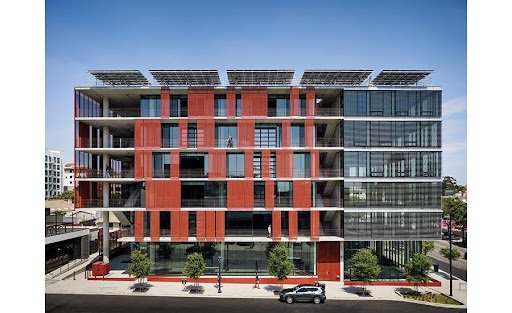Introduction
- The rapid pace of urbanization and the intensifying effects of climate change have spotlighted the need for High-Performance Buildings (HPBs).
- These structures are designed not only to conserve resources but also to enhance energy efficiency, ensure occupant comfort, and adapt to climate risks. HPBs represent a paradigm shift in sustainable construction by integrating cutting-edge technologies and practices.
What Are High-Performance Buildings (HPBs)?
- High-Performance Buildings (HPBs) are structures designed to surpass conventional standards in terms of energy efficiency, sustainability, operational performance, and occupant well-being.
- They address modern challenges like resource depletion, rising energy demands, and extreme weather resilience.

Key Features of HPBs
- Integrative Design: A hallmark of HPBs is their holistic design approach, bringing together architects, engineers, sustainability experts, and owners to achieve measurable goals.
- Example: The Indian Institute of Human Settlements (IIHS) campus in Bengaluru achieves daylight optimization and cooling efficiencies through collaborative planning.
- Sustainable Material Choices: HPBs prioritize materials with low embodied carbon, high durability, and energy efficiency. These materials undergo lifecycle cost analysis to ensure environmental sustainability and long-term performance.
- Example: IIHS Bengaluru selects materials balancing comfort, durability, and efficiency over 50 years. Additionally, low-emission interiors enhance indoor air quality by minimizing harmful volatile organic compounds.
- Energy Efficiency Strategies: HPBs aim for net-zero or net-positive energy, where the energy generated equals or exceeds consumption. Renewable sources such as solar and wind are integral to these designs.
- Example: The Infosys Hyderabad campus employs radiant cooling, task lighting, and daylighting systems, significantly reducing energy use.
- Water Conservation: Water scarcity is addressed through advanced technologies like rainwater harvesting, efficient fixtures, and wastewater recycling.
- Example: Infosys campuses recycle 100% of wastewater using aerobic membrane bioreactors, achieving zero-discharge status.
- Performance Monitoring: Advanced sensors and monitoring systems track real-time energy and water usage, indoor air quality, and operational efficiency.
- Example: The IIHS Bengaluru campus uses AI-powered smart devices for thermal regulation and resource optimization.
- Resilience to Climate Risks: HPBs are equipped to withstand extreme weather conditions by integrating flood protection, passive survivability measures, and durable materials. They also feature renewable energy systems to ensure functionality during outages.
Read also: India-Nigeria Relations: Key Insights for UPSC Exam
Advantages of High-Performance Buildings
- Economic Benefits:
- Energy Cost Savings: Advanced energy-efficient systems significantly reduce heating, cooling, and lighting costs.
- Increased Property Value: Green certifications and low operational costs make HPBs more attractive to buyers and tenants, commanding premium market rates.
- Environmental Benefits:
- Reduced Carbon Footprint: The reliance on renewable energy and energy-efficient systems reduces greenhouse gas emissions.
- Resource Optimization: Effective management of water and energy resources, combined with the use of recycled materials, ensures minimal environmental impact.
- Social and Health Benefits:
- Enhanced Indoor Air Quality: The use of non-toxic materials and advanced ventilation systems promotes occupant health.
- Improved Comfort: Thermal insulation, acoustic controls, and optimized lighting systems create a comfortable and productive environment for occupants.
Challenges in Implementing HPBs
- Financial Challenges:
- Higher Initial Costs: Advanced materials, technologies, and integrated designs often result in higher upfront investments.
- Budget Constraints: For smaller projects or regions with limited financial resources, balancing cost and sustainability goals can be challenging.
- Technical Challenges:
- Complex Design and Planning: HPBs demand intensive collaboration among architects, engineers, and sustainability experts, complicating project management.
- Maintenance Complexity: Sophisticated systems like smart HVAC and building automation require specialized skills for maintenance and troubleshooting.
- Regulatory and Policy Challenges:
- Lack of Standardized Metrics: The absence of universally accepted definitions of “high performance” creates inconsistencies in design, maintenance, and operations.
- Evolving Regulations: Frequent updates to building codes and certification standards require additional investments to ensure compliance.
Global Efforts Supporting HPBs
- European Union: The Green Deal emphasizes energy-efficient retrofits and sustainable building practices, targeting climate neutrality by 2050.
- Germany: The KfW Bank offers low-interest loans to promote energy-efficient construction.
- United States: Programs like Energy Star and LEED provide tax incentives and promote green building practices.
- Denmark: Building regulations like BR18 encourage sustainable construction through financial incentives.
India’s Journey Toward High-Performance Buildings
- National Initiatives: The National Action Plan on Climate Change promotes energy-efficient construction, with the Energy Conservation Building Code (ECBC) aiming for a 30% reduction in energy demand. Cities like Hyderabad and Pune incentivize ECBC-compliant buildings.
- Examples: ITC Green Centre (Gurugram), TCS Siruseri IT Park (Chennai), and Embassy TechVillage (Bengaluru).
- Green Certification Systems:
-
- Green Rating for Integrated Habitat Assessment (GRIHA): Over 3,000 projects are registered under GRIHA, prioritizing sustainability.
- Indian Green Building Council (IGBC): With over 14,000 certified projects spanning 12.5 billion sq. ft., IGBC promotes eco-friendly practices in construction.
Way Forward
- Strengthening Building Standards: Regularly updating and enforcing energy and sustainability codes will help align new projects with high-performance benchmarks.
- Expanding Financial Incentives: Grants, subsidies, and tax credits can offset the initial costs of HPBs, encouraging wider adoption.
- Investing in Research and Development: Funding for innovative materials, energy-efficient technologies, and design tools will advance the HPB sector.
- Mandating Transparent Reporting: Requiring the disclosure of energy use, water consumption, and carbon footprints will foster accountability and innovation in the industry.

